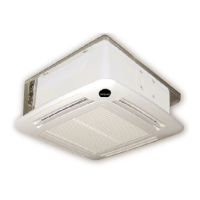31
La mandata d’aria verso il locale attiguo richiede la chiusu-
ra con materiale isolante (fornito a corredo dell’accessorio
flangia KFA) del canale di mandata nella bacinella, corri-
spondente al condotto.
L’apertura di mandata è chiusa, per aprirla applicare la flan-
gia (accessorio KFA) fissandola alla bacinella con le 4 viti a
corredo, tagliare il polistirolo seguendo la traccia incisa ed
il profilo della flangia avendo cura di non danneggiare le
parti retrostanti.
Sulla parete divisoria tra locale condizionato, in cui è instal-
lata l’unità, ed il locale attiguo, è necessario applicare una
bocca di ripresa aria.
Eseguire il canale come descritto nel capitolo “Aria esterna
e di rinnovo”.
MANDATA ARIA TRATTATA IN LOCALE ATTIGUO
ARIA ESTERNA DI RINNOVO
Le aperture laterali, sulla bacinella in polistirolo, consento-
no la realizzazione separata di un condotto di aspirazione
aria esterna di rinnovo e di mandata aria trattata verso un
locale attiguo.
La bocchetta di aspirazione aria esterna di rinnovo è chiusa
da un tappo in plastica facilmente rimovibile.
Per collegare la bocchetta con il canale utilizzare la flangia KFA
(accessorio) fissandola alla bacinella con le 4 viti a corredo.
Utilizzare materiale idoneo al funzionamento con tempera-
ture di 80 °C in continuo. I condotti possono essere di tipo
flessibile in poliestere (con anima spiralata in acciaio) oppu-
re in alluminio corrugato, rivestiti esternamente con mate-
riale anticondensa (fibra di vetro 12 ÷ 25 mm di spessore).
Ad installazione terminata, le superfici non coibentate dei
condotti dovranno essere rivestite con isolante anticondensa
(es. neoprene espanso, 6mm spessore).
Per vincere la caduta di pressione dovuta alla bocchetta di
aspirazione aria di rinnovo, condotto, filtro, etc., occorrerà
installare un ventilatore opportunamente dimensionato.
Per il funzionamento invernale con apporto di aria esterna,
si consiglia di montare un termostato antigelo tarato a 2 °C,
con il bulbo posto sulla tubazione d’uscita dell’acqua, che
intercetta il ventilatore supplementare.
La portata d’aria esterna non deve superare il 10 % della
portata d’aria totale, per evitare inconvenienti di funziona-
mento od eccessiva rumorosità.
Installare all’esterno una griglia d’aspirazione con telaio
portafiltro ispezionabile, per impedire l’aspirazione di pol-
vere e foglie che possono ostruire irrimediabilmente la bat-
teria di scambio termico dell’unità.
L’installazione del filtro evita anche l’installazione di una
serranda di chiusura del canale durante i periodi d’inattività.
The delivery of the air towards the adjacent room requires
the closure of the delivery channel in the basin, correspon-
ding with the duct, with isolating tape (supplied with the
KFA accessory flange).
The aperture of the delivery is closed. To open it apply the
flange (accessory KFA) fixing it to the sink with 4 screws
supplied, cut the polystyrene following the indented track
and the edge of the flange being careful not to damage the
parts behind.
Close the delivery grille that corresponds to the side occu-
pied by the same flange with the gasket supplied with the
KFA accessory.
It is necessary to install an air recovery vent on the wall
dividing the two air-conditioned room the unit is installed in
and the adjacent room.
Make the channel as described in the "External and fresh
air" chapter.
DELIVERY OF TREATED AIR TO ADJACENT ROOM
EXTERNAL FRESH AIR
The side openings on the polystyrene basin, permit the
separate attachment of an external intake fresh air pipe and
a delivery pipe for treated air towards an adjacent room.
The external fresh air intake vent is covered by an easy to
remove cap made of plastic.
To connect the vent with the canal, use the KFA flange
(accessory) fixing it to the basin with the four screws sup-
plied.
Use material that is suitable for the operation with conti-
nuous temperatures of 80 °C. The ducts can be flexible
made of polyester (with spiral steel core) or made of corru-
gated aluminium, externally coated with anti-condensate
material (fibre glass 12 ÷ 25 mm in thickness). When the
installation is complete, the non-insulated surfaces must be
coated with anti-condensate insulation (e.g. expanded neo-
prene, 6 mm thickness).
To beat the fall in pressure due to the renewed air intake
vent, duct, filter etc., it is necessary to install a suitably-sca-
led fan.
For winter operation with the intake of outside air, it is advi-
sable to fit an antifreeze thermostat set at 2 °C, with the
bulb placed on the water outlet pipe, that shuts off the sup-
plementary fan.
The external air flow must not exceed 10 % of the total air
flow to prevent operating problems or excessive noise.
Install outside an intake grill with filter frame that can be
inspected, to prevent dust and leaves being sucked in that
could block up the unit's heat exchange battery irreparably.
The installation of the filter also avoids the installation of a
channel closure gate during periods of inactivity.

